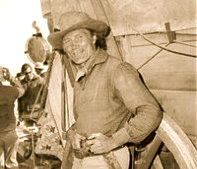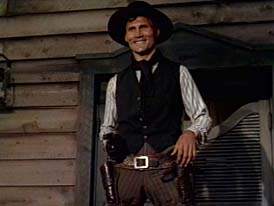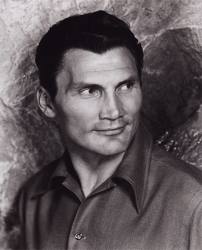Jack Palance

Jack Palance Tribute
(born Volodymyr Jack Palahniuk; Ukrainian: Володимир Палагнюк; February 18, 1919 – November 10, 2006) was an American actor. During half a century of film and television appearances, Palance was nominated for three Academy Awards, all as Best Actor in a Supporting Role, winning in 1991 for his role in City Slickers.
Early life
Palance was born Volodymyr Palahniuk in the Lattimer Mines section of Hazle Township, Luzerne County, Pennsylvania, to Anna (née Gramiak) and Ivan Palahniuk, an anthracite coal miner. Palance’s parents were Ukrainian immigrants, his father a native of Ivane Zolote in southwestern Ukraine (modern Ternopil province) and his mother from the Lviv region.
One of six children, he worked in coal mines during his youth before becoming a professional boxer in the late 1930’s. Fighting under the name Jack Brazzo, Palance reportedly compiled a record of 15 consecutive victories with 12 knockouts before losing a close decision to future heavyweight contender Joe Baksi in a “Pier-6” brawl. Years later he recounted: “Then, I thought, you must be nuts to get your head beat in for $200.”
With the outbreak of World War II, Palance’s boxing career ended and his military career began as a member of the United States Army Air Forces. Palance’s rugged face, which took many beatings in the boxing ring, was said to have become disfigured while bailing out of a burning B-24 Liberator bomber during a training flight over southern Arizona (where Palance was a student pilot). His distinctive cheekbones and deep-set eyes were said to have been the result of reconstructive surgery. The story behind Palance’s face was repeated numerous times (including in respected film reference works), but upon his death, several obituaries of Palance quoted him as saying that the entire story had been contrived: “Studio press agents make up anything they want to, and reporters go along with it. One flack created the legend that I had been blown up in an air crash during the war, and my face had to be put back together by way of plastic surgery. If it is a ‘bionic face,’ why didn’t they do a better job of it?”
Palance reportedly was discharged in 1944. After the war he attended Stanford University, leaving one credit shy of graduating to pursue a career in the theatre. (A bachelor of arts degree in Drama was conferred to him, honorary Class of ’49, in ’95) During his university years, to make ends meet he also worked as a short order cook, waiter, soda jerk, lifeguard at Jones Beach State Park, and photographer’s model.
Palance’s acting break came as Marlon Brando‘s understudy in A Streetcar Named Desire, and he eventually replaced Brando on stage as Stanley Kowalski.
In 1947, Palance made his Broadway debut, and this was followed three years later by his screen debut in the movie Panic in the Streets (1950). The very same year, he was featured in Halls of Montezuma about the U.S. Marines in World War II, where he was credited as “Walter (Jack) Palance”. Palance was quickly recognized for his skill as a character actor, receiving an Oscar nomination for only his third film role, as Lester Blaine in Sudden Fear.
Shane
 Palance earned his second Oscar nomination playing cold-blooded gunfighter Jack Wilson in the 1953 cinema classic Shane
Palance earned his second Oscar nomination playing cold-blooded gunfighter Jack Wilson in the 1953 cinema classic Shane
The following year, Palance was again nominated for an Oscar, this time for his role as the hired gunfighter Jack Wilson in Shane. Several other Western roles followed, but he also played such varied roles as Dr. Jekyll and Mr. Hyde, Dracula and Attila the Hun. Three years before Palance played the part, comic book artist Gene Colan based his interpretation of Dracula for the acclaimed series The Tomb of Dracula on Palance, explaining “He had that cadaverous look, a serpentine look on his face. I knew that Jack Palance would do the perfect Dracula.”
In 1957, Palance won an Emmy for best actor for his portrayal of Mountain McClintock in the Playhouse 90 production of Rod Serling‘s Requiem for a Heavyweight.
Jean-Luc Godard persuaded Palance to take on the role of Hollywood producer Jeremy Prokosch in the 1963 nouvelle vague movie Le Mépris, with Brigitte Bardot and Michel Piccoli. Although the main dialogue was in French, Palance spoke mostly English.
Later, in 1966, he appeared in the movie Alice Through the Looking Glass directed by Alan Handley in which he played the Jabberwocky.
In 1969, while still busy making movies, Palance recorded a country music album on Warner Bros. Records. The album recalled the Lee Hazlewood music that was popular at the time. Recorded in Nashville, the album is a playful country rock romp not unlike other late 60’s Nashville recordings and featured Palance’s self-penned classic song “The Meanest Guy That Ever Lived”. The album was re-released in 2003 by the “Walter” label on CD.
Palance also starred the television series Bronk between 1975 and 1976 for MGM Television.
Palance received a major career boost when he began hosting a television revival of Ripley’s Believe It or Not! in 1982. The weekly series ran from 1982 to 1986 on the American ABC network. The series was wildly popular during its four-year run, owing a great deal of its success to Palance’s eccentric performances. The series also starred three different co-hosts from season to season, including Palance’s daughter Holly Palance, actress Catherine Shirriff and singer Marie Osmond. Ripley’s Believe It or Not! was rerun in syndication on the Sci-fi Channel (UK) and Sci-fi Channel (US) during the 1990’s.
Palance’s success on Ripley’s Believe It or Not! resulted in a demand for his services. He made memorable appearances in Young Guns (1988), Tango & Cash (1989) and Tim Burton‘s Batman (1989), all of which served to reinvigorate his movie career. Palance would be involved in new projects each year right up to the start of the 21st century. He also performed on Roger Waters‘ first solo album release The Pros and Cons of Hitch Hiking in 1984.
Palance, at the time chairman of the Hollywood Trident Foundation, walked out of a Russian Film Festival in Hollywood. After being introduced, Palance said, “I feel like I walked into the wrong room by mistake. I think that Russian film is interesting, but I have nothing to do with Russia or Russian film. My parents were born in Ukraine: I’m Ukrainian. I’m not Russian. So, excuse me, but I don’t belong here. It’s best if we leave.” Palance was awarded the title of “People’s Artist” by the President Vladimir Putin on that occasion; however, Palance refused the title.
In 2001, Palance returned to the recording studio as a special guest on friend Laurie Z‘s Heart of the Holidays album to narrate the famous classic poem “The Night Before Christmas.”
In 2002, he starred in the television movie Living with the Dead opposite Ted Danson, Mary Steenburgen and Diane Ladd. In 2004, he starred in another television production, Back When We Were Grownups, opposite Blythe Danner, his performance as Poppy being Palance’s last.
According to writer Mark Evanier, comic book creator Jack Kirby modeled his character Darkseid on the actor.
Four decades after his film debut, Palance won an Academy Award for Best Supporting Actor on March 30, 1992, for his performance as cowboy Curly Washburn in the 1991 comedy City Slickers. Stepping onstage to accept the award, the intimidatingly fit 6′ 4″ (1.93 m) actor looked down at 5′ 7″ (1.70 m) Oscar host Billy Crystal (who was also his co-star in the movie), and joked – mimicking one of his lines from the film – “Billy Crystal… I crap bigger than him.” He then dropped to the floor and demonstrated his ability, at age 73, to perform one-handed push-ups.
Crystal turned this into a running gag. At first, he quipped, “I told Jack before the ceremony, ‘Decaf, Jack, decaf'”. Then, at various points in the broadcast, he announced that Palance had done the following:
- was backstage on the Stairmaster;
- “…just bungee-jumped off the Hollywood sign“;
- rendezvoused with the Space Shuttle in orbit;
- fathered all the children in a production number;
- been named People magazine‘s Sexiest Man Alive;
- had won the New York primary election.
At the end of the broadcast, Crystal told everyone he would like to see them again, “but I’ve just been informed Jack Palance will be hosting next year.”
Years later Billy Crystal appeared on Inside the Actors Studio with James Lipton and fondly recalled that after the Oscar ceremony, Palance approached him during the reception, “stopped me and put his arms out and went, ‘Billy Crystal, who thought it would be you?’. It was his really funny way of saying thank you to a little New York Jewy guy who got him the Oscars.”
In a spoof of that Oscar highlight, the opening of the 1993 Oscars featured Palance appearing to drag in an enormous Academy Award statuette, with Crystal, again hosting, riding on the rear end of it.
On November 10, 2006, Palance died of natural causes at age 87 at his daughter Holly’s home in Montecito in Santa Barbara County. His remains were cremated, his ashes retained by family and friends. Jack Palance lived for a number of years around Tehachapi, near Bakersfield, in southern California.
Palance has a star on the Hollywood Walk of Fame at 6608 Hollywood Boulevard. In 1992, he was inducted into the Western Performers Hall of Fame at the National Cowboy & Western Heritage Museum in Oklahoma City, Oklahoma.





